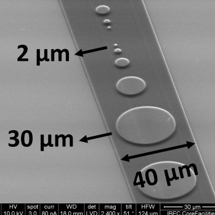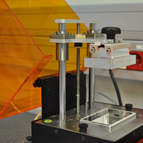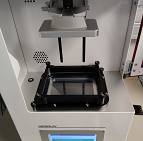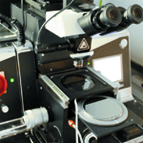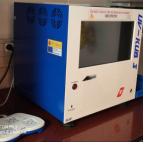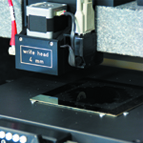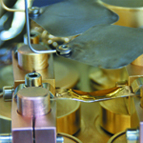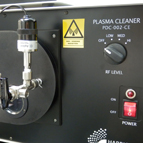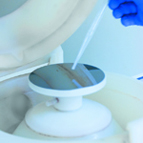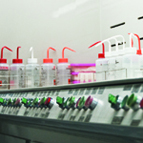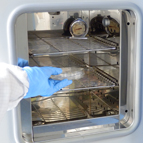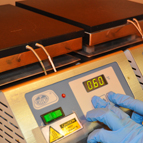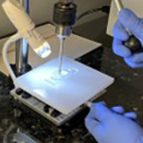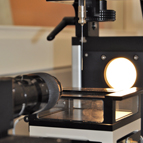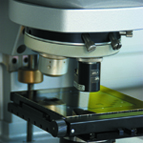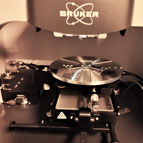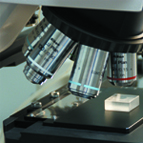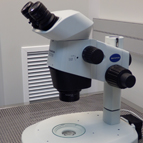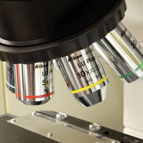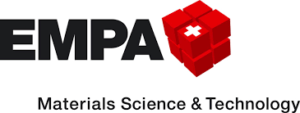The MicroFabSpace is one of the most experienced services in the IBEC’s Core Facilities, with a cleanroom (10.000 class) research space specialized in the fabrication and characterization of micro-devices and micro-structures.
Extensively equipped with instruments aimed at the development of devices required in bioengineering, the MicroFabSpace gathers a large catalog of specific techniques and protocols and has a specialized technical staff, which provides assistance in advanced research, including design, development and analysis of fabricated devices.
We offer the tools with which our users can put their innovative ideas into practice, but also the extensive experience of the Facilities and the Institute to guide and provide services to public and private clients, in their development projects, in the fields of bioengineering, BioMEMS, materials science, tissue engineering and microfluidics.
The use of the facility is open to other public institutions and private companies.
For more information please contact microfab@ibecbarcelona.eu.
SERVICES
Access to 10,000 class cleanroom, specialized in the Microfabrication and characterization of biomedical devices.
Training in Microfabrication and Characterization techniques, equipment, and processes for autonomous use (self-user mode).
Customized Microfabrication and Characterization Services, led by scientific staff (order mode with previous quotation).
Microfabrication
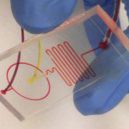
Custom design and fabrication of microfluidic masters, and other applications, based optical lithography with SU-8 (down to 1μm lateral resolution).
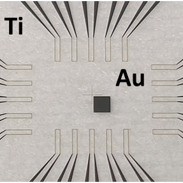
Custom design and fabrication of microstructured masters by direct laser lithography (DWL).
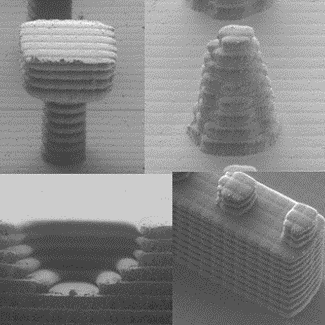
Custom design and fabrication of microfluidic masters, and other applications, based on 3D printing (down to 100μm lateral resolution).
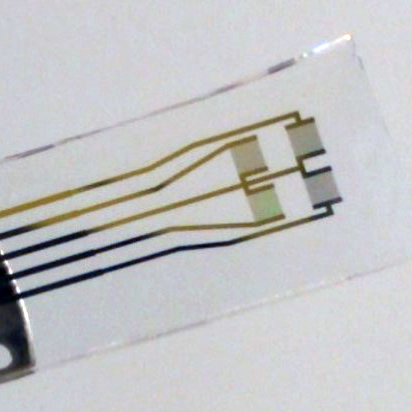
Design and fabrication of microelectrodes, and other microelectronics’ structures.

Design and fabrication of high-resolution nanostructures, by electron beam lithography (down to 100nm lateral resolution).

Thin film deposition by thermal evaporation, electron beam evaporation and sputtering.
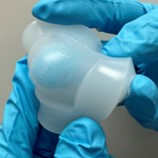
Fabrication of microfluidic chips based on PDMS.
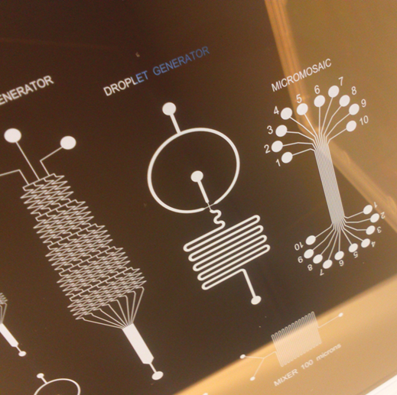
Design and fabrication of Cr photomasks for photolithographic processes (down to 1μm lateral resolution).
Characterization
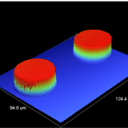
Surface topographic analysis using optical interferometry and mechanical profilometry.
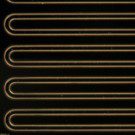
Optical characterization of samples by bright and dark field optical microscopy.

Measurements of the contact angle for the wettability properties of the surface.
EQUIPMENT
| Microfabrication
| Characterization
Microfabrication
Click on an item for more information.
Characterization
Click on an item for more information.
More characterization services are available in the Microscopy Characterization facility.
BECOME USER
To become a MicroFabSpace user, please follow the steps below.
- 1. Read the ‘information and regulations for users’ document:
Terms and conditions of use - 2. Fill in the new user application forms:
a. Customer registration form: to be completed by the person who assumes the costs resulting from the provision of services carried out at MicroFabSpace.
Customer Registration Request
b. User linked to a customer registration form: to be completed by the person that will directly use MicroFabSpace services. This person must be linked to a customer that will assume the costs resulting from the services provided.
User linked to customer registration form - 3. Send the completed application forms to microfab@ibecbarcelona.eu
EXTERNAL CLIENTS
USERS' PUBLICATIONS
Why acknowledge MicroFabSpace and its staff in your publications?
- To demonstrate the value of IBEC’s common facility and staff to the scientific community
- To secure funding and new investments in future equipment and better facilities
- To make research better, and keep improving
For every publication accepted by a journal that properly refers to the use of IBEC’s MicroFabSpace, authors will receive a free hour of instrument use (excluding consumables). Simply inform us about your publication to receive your free time. In addition, we’ll also display your publication on our web page.
 |
Nedjari S, Awaja F, Altankov G. (2017). Three Dimensional Honeycomb Patterned Fibrinogen Based Nanofibers Induce Substantial Osteogenic Response of Mesenchymal Stem Cells Sci Rep. 7(1):15947 |
 |
Inés Temiño, Freddy G. Del Pozo, M. R. Ajayakumar, Sergi Galindo, Joaquim Puigdollers, Marta Mas‐Torrent (2016). A Rapid, Low‐Cost, and Scalable Technique for Printing State‐of‐the‐Art Organic Field‐Effect Transistors Adv. Mat. Technologies, 1,5 |
 |
David C. Fernández‐Remolar, Joan Santamaría, Ricardo Amils, Victor Parro, D. Gómez‐Ortíz, Matthew R. M. Izawa, Neil R. Banerjee, Raúl Pérez Rodríguez, Nuria Rodríguez, Nieves López‐Martínez (2015). Formation of iron‐rich shelled structures by microbial communities Biogeosciences, 120, 1, 147-148 |
 |
Ziqiu Tong, Miriam Segura-Feliu, Oscar Seira, Antoni Homs-Corbera, José Antonio Del Río and Josep Samitier (2015). A microfluidic neuronal platform for neuron axotomy and controlled regenerative studies. RSC Advances, 90 |
 |
Galán T, Prieto-Simón B, Alvira M, Eritja R, Götz G, Bäuerle P, Samitier J. (2015). Label-free electrochemical DNA sensor using “click”-functionalized PEDOT electrodes. Biosens Bioelectron. 15, 74:751-6 |
 |
García S, Sunyer R, Olivares A, Noailly J, Atencia J, Trepat X. (2015). Generation of stable orthogonal gradients of chemical concentration and substrate stiffness in a microfluidic device. Lab Chip. 21;15(12):2606-14 |
 |
Ziqiu Tong, Oscar Seira, Cristina Casas, Diego Reginensi, Antoni Homs-Corbera, Josep Samitier and J. Antonio Del Rio (2015). Engineering a functional neuro-muscular junction model in a chip RSC Adv. |
 |
Rigat Brugarolas, L. G., Elizalde Torrent, A., Bernabeu, M., de Niz, M., Martin Jaular, L., Fernandez Becerra, C., Homs Corbera, A., Samitier, J. & del Portillo, H. A. (2014). Functional microengineered model of the human splenon-on-a-chip Lab Chip, 14(10):1715-24 |
 |
Maria Antònia Arbós, Maria Teresa Quiles, Pere Huguet, Manel Armengol and Manuel López-Cano (2013). Biological Scaffolds: Molecular Surface Characterization and Host-Tissue Response General Surgery Research Group, Vall d’Hebron Research Institute (VHIR), UAB, Barcelona, Spain |
 |
Castillo-Fernández, O., Rodríguez-Trujillo, R., Gomila, G.& Samitier, J. (2013). High-speed counting and sizing of cells in an impedance flow microcytometer with compact electronic instrumentation Microfluidics and Nanofluidics, in press |


